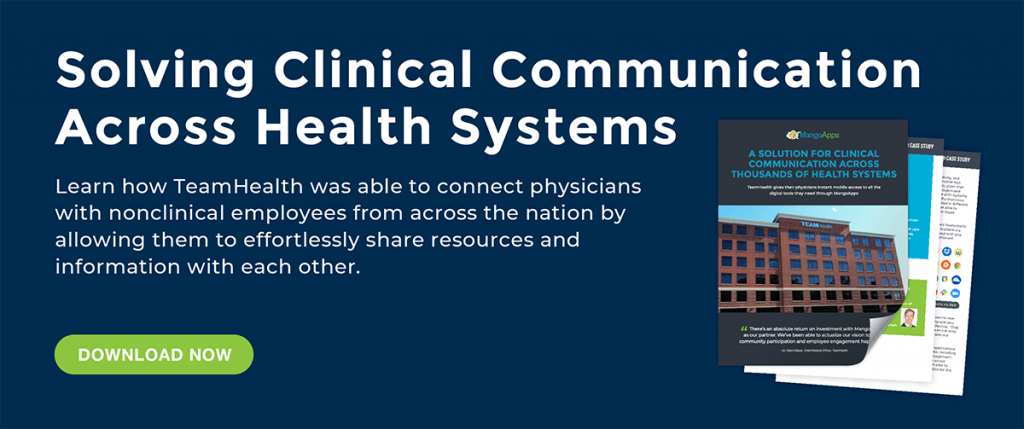In today’s fast-paced and evolving world, digital transformation is reshaping every industry, and healthcare is no exception. By leveraging technology, healthcare organizations can radically enhance the employee experience, leading to improved efficiency, better patient care, and overall institutional growth. The benefits of digital transformation in healthcare reach far beyond just simplifying administrative tasks.
In fact, it presents an exciting opportunity for healthcare employees to redefine their roles. They can eliminate unnecessary manual tasks and focus more on their primary objective—providing superior patient care. Digital transformation can assist in streamlining communication, fostering collaboration, automating routine tasks, and offering real-time access to vital information. These advancements contribute to creating a more empowered, motivated, and satisfied workforce, ultimately resulting in a significantly heightened patient experience.
As health system administrators, embracing digital transformation is crucial to stay competitive and deliver high-quality care in the digital era. This article aims to delve deep into how a digital transformation can revolutionize the healthcare employee experience and why it’s a pivotal step in modernizing healthcare operations.
Digital transformation, at its core, signifies the infusion of digital technology into all spheres of a business, resulting in fundamental changes to how businesses operate and deliver value to their users. In the healthcare sector, the resonance of technology has never been more palpable.
Historical Perspective
Historically, healthcare systems have been notoriously slow when it comes to adopting new technologies. Many factors have contributed, including complex regulatory environments, concerns over patient privacy, and the sheer scale of data involved. Often, healthcare workers had to juggle multiple tasks manually, from maintaining extensive paperwork to communicating with various departments, which was not only time-consuming but also left ample room for errors.
However, the advent of digital technologies began to change the landscape. The initial phase of digital transformation in healthcare was marked by the introduction of Electronic Health Records (EHRs). These digitalized versions of patient’s paper charts were a game changer, providing real-time, patient-centered records accessible to authorized users instantly. This not only streamlined the documentation process but also made health information available for coordinated and efficient care.
Effects of the AI Revolution
As we moved into the 21st century, the rise of advanced technologies like Artificial Intelligence (AI) and Machine Learning (ML) have widened the scope of benefits of digital transformation in healthcare. For example, AI and ML have proven invaluable in predictive analysis, risk assessment, and even in diagnosing diseases. These technologies allow healthcare professionals to make more informed decisions and deliver personalized patient care.
In recent years, digital transformation has expanded to include even more groundbreaking technologies, especially in the realm of employee-facing systems. These systems encompass a range of applications and platforms designed to streamline administrative tasks, improve communication, and enhance productivity.
Digital tools such as advanced scheduling software eliminate the need for manual rostering and allow for dynamic shift management. This reduces administrative burden while increasing employees’ flexibility. On the other hand, digital communication platforms enable real-time, seamless interaction among healthcare teams, promoting collaboration and facilitating swift decision-making. For example, see MangoApps’ employee app for healthcare.
Furthermore, AI-powered decision-support systems provide healthcare professionals with predictive insights. These can help with diagnosis, and suggest treatment plans, strengthening their decision-making capabilities. Employee-facing digital systems also include Learning Management Systems (LMS), offering continuous learning opportunities to healthcare workers, thereby fostering professional growth and development.
By integrating these digital systems, healthcare institutions can provide their employees with a smoother, more efficient working environment. This digital empowerment leads to enhanced job satisfaction, reduced stress, and ultimately, a higher standard of patient care. Taken together, these advancements highlight the tremendous potential of digital transformation to elevate the employee experience in healthcare.

Key Benefits of Digital Transformation in Healthcare
1. Enhanced Operational Efficiency
Digital transformation significantly enhances operational efficiency, one of its most notable benefits. Through automation of routine tasks, digital tools free up healthcare workers’ time, allowing them to focus more on patient care. For instance, automated billing systems eliminate the need for manual invoicing, reducing errors and speeding up the billing process.
Similarly, predictive analytics tools can forecast patient needs and trends, allowing for efficient resource allocation. Moreover, digitization of medical records not only simplifies record-keeping but also improves accessibility of patient information. This can facilitate a more streamlined and efficient care delivery process.
2. Scalability and Flexibility
Digital transformation provides healthcare systems with scalability and flexibility, which are crucial in this ever-evolving industry. As healthcare organizations grow, digital solutions can effortlessly scale to match their increasing demands. They offer the flexibility to seamlessly integrate new functionalities as needed, ensuring the healthcare system can adapt to changing circumstances and requirements. For example, cloud-based storage systems provide scalable solutions for data storage and retrieval. As patient data grows, these systems can be expanded accordingly, without the need for extensive physical infrastructure. Furthermore, telemedicine – an innovation made possible through digital transformation – embodies flexibility by allowing healthcare professionals to consult with patients remotely, maximizing reach and access to care.
Cloud systems in healthcare extend beyond mere data storage facilities. They are instrumental in accelerating the expansion of operations. Cloud systems provide healthcare organizations with the agility and scalability necessary in the dynamic healthcare landscape. With the cloud, applications and services can be quickly deployed across various locations, facilitating instant setup and expansion of facilities. This is particularly advantageous in emergency or pandemic situations where rapid operational scaling is paramount.
Moreover, cloud systems provide a robust platform for integrating and deploying various digital healthcare solutions. These include telemedicine, AI-based diagnostic tools, and remote patient monitoring systems. This ability to quickly implement and scale up innovative solutions can significantly enhance operational efficiency and patient care.
Also, cloud-based platforms enable real-time collaboration among healthcare professionals, irrespective of their location. This aids in efficient coordination of care, especially for patients with complex needs. Through the cloud, healthcare organizations can break down geographical and logistical barriers, allowing them to deliver high-quality care more expansively and efficiently. In essence, the cloud enables benefits of digital transformation by driving the rapid growth and expansion of healthcare operations.
3. Enhanced Collaboration and Communication
Digital transformation is a powerful catalyst for enhanced collaboration and communication within the healthcare sector. By leveraging digital tools and platforms, healthcare professionals can communicate and collaborate more effectively, leading to better patient outcomes. Real-time communication platforms, for instance, allow healthcare teams to share information, discuss patient cases, and make collective decisions swiftly and seamlessly. This fosters a more coordinated approach to patient care. As a result, care teams can reduce the risk of miscommunication or information gaps.
Digital transformation also facilitates cross-departmental collaboration and interdisciplinarity in healthcare settings. It enables different departments and units to access relevant patient data and collaborate on comprehensive care plans. For instance, with digital records and cloud-based platforms, a patient’s complete medical history can be shared across various departments. This allows for a more integrated approach to treatment. This aids in coordinating efforts, preventing duplicate testing, and ensuring all healthcare providers are working from the same information.
The Patient-Facing Side of Collaboration
Moreover, digital platforms also facilitate communication between healthcare providers and patients. Patient portals and mobile apps allow patients to access their health information, make appointments, and communicate with their healthcare providers. This fosters better patient engagement, empowering individuals to participate actively in their healthcare journey.
Looking ahead, the integration of AI and machine learning into communication platforms holds immense potential for enhancing communication in healthcare. For instance, AI-powered chatbots can handle routine inquiries, freeing up healthcare professionals’ time for more complex tasks. Machine learning algorithms could also be utilized to analyze communication patterns and identify areas for improvement. Such advancements can not only streamline communication but also generate insights to further enhance healthcare delivery.
In conclusion, digital transformation greatly enhances benefits like collaboration and communication in healthcare. By leveraging digital tools and platforms, healthcare organizations can cultivate a more integrated, efficient, and patient-centered care experience. This not only improves the quality of care but also drives patient satisfaction and overall healthcare outcomes.
4. Continuous Learning and Development
Digital transformation in healthcare provides a fertile ground for continuous learning and development of healthcare professionals. The integration of digital tools and platforms in healthcare organizations creates a wealth of data and learning resources that can be tapped into for skills enhancement, knowledge expansion, and professional development.
One of the prominent ways digital transformation fosters continuous learning is by providing access to vast amounts of real-time data. With the help of digital technologies, healthcare professionals can access up-to-date patient information, medical research, and best practices in the field, enabling them to stay abreast with the latest advancements in healthcare. This constant access to information not only helps in immediate decision-making but also contributes to the broader knowledge base of the medical professionals.
The Benefits of Digital Learning
Furthermore, digital transformation also allows for the creation of a digital learning environment, where training programs and educational resources can be made available online. This paves the way for e-learning and virtual training programs, making education more accessible and flexible for healthcare professionals. For instance, simulation-based training using virtual or augmented reality can provide a highly interactive and immersive learning experience. This can significantly enhance the learning process by allowing healthcare professionals to practice procedures and treatment protocols in a risk-free, virtual environment before applying them in real-life situations.
Moreover, digital tools can also facilitate peer-to-peer learning and collaboration among healthcare professionals. Online forums and communication platforms can serve as a space for healthcare professionals to share insights, discuss cases, and learn from each other. This can foster a culture of knowledge sharing and collective learning within healthcare organizations, leading to improved practices and patient outcomes. It is also a great strategy for boosting employee engagement.
In essence, the benefits of digital transformation include revolutionizing the learning and development landscape in healthcare. By leveraging digital tools and platforms, healthcare organizations can create a dynamic, accessible, and collaborative learning environment that drives continuous professional development and enhances healthcare delivery.
5. Reduction in Administrative Burden
Digital transformation plays a crucial role in reducing administrative burdens in healthcare organizations. This major advantage comes to light when digital tools are utilized to automate routine tasks, manage patient data, streamline workflows, and improve the overall efficiency of the healthcare system.
One of the primary ways that digital transformation aids in reducing administrative burdens revolves around the automation of repetitive tasks. With digital tools like machine learning and robotic process automation (RPA), healthcare organizations can automate various administrative tasks, such as patient scheduling, data entry, and billing. This not only saves considerable time but also reduces the chances of human errors. As a result, healthcare professionals can focus more on patient care rather than administrative duties, thereby enhancing the quality of care.
Centralizing Patient Data
Moreover, digital transformation also streamlines data management in healthcare settings. In traditional healthcare systems, managing patient data can be a daunting task, with information scattered across multiple platforms and databases. However, with digital platforms, healthcare organizations can centralize patient data, making it easily accessible for healthcare providers. For instance, Electronic Health Records (EHRs) enable healthcare professionals to access a patient’s complete medical history at the click of a button. This eliminates the need to sift through piles of paperwork, thereby saving time and improving efficiency.
Digital transformation also provides intelligent solutions to streamline workflows in healthcare institutions. Through the utilization of artificial intelligence (AI) and advanced data analytics, healthcare organizations can optimize their operations, making workflows more efficient and reducing administrative burdens. For instance, predictive analytics can help in forecasting patient volume and adjust staffing levels accordingly, reducing waiting times and improving patient satisfaction.
In conclusion, digital transformation significantly reduces the administrative burdens in healthcare organizations. By automating routine tasks, streamlining data management, and optimizing workflows, digital transformation enables healthcare professionals to focus more on what truly matters—providing high-quality patient care.

Boosting engagement at Columbia Basin Health Association
Learn how CBHA got over 90% user adoption and improved staff alignment with MangoApps
6. Enhanced Security and Role-Based Access
Digital transformation also plays an important role in enhancing security and implementing role-based access in healthcare organizations. Cybersecurity has become a top concern for the healthcare industry, particularly in light of recent data breaches and cyber attacks. Digital transformation brings advanced security technologies and protocols that can protect sensitive patient data and ensure compliance with legal and regulatory requirements.
One advantage of digital transformation in this regard is the implementation of smarter, more secure data storage solutions. Digital platforms use encryption, multi-factor authentication, and other advanced security techniques to protect patient information. They also offer secure cloud storage solutions that enable healthcare organizations to safely store and manage large volumes of patient data. The cloud-based platforms come with in-built security measures that safeguard against data loss, unauthorized access, and cyber threats.
Role-Based Access Control
Moreover, digital transformation aids in the establishment of role-based access control (RBAC) in healthcare settings. RBAC is a method of regulating access to system resources based on the roles of individual users within the organization. In a healthcare context, this means that healthcare professionals can only access patient data and other sensitive information that is relevant to their role and necessary for their job function.
This ensures that sensitive patient data is only accessible to authorized personnel, thereby reducing the risk of data breaches and improving data privacy. Digital platforms can automate the process of managing and assigning these roles, making it easier for healthcare organizations to implement and maintain RBAC.
Furthermore, digital transformation also facilitates continuous monitoring and real-time alerts for potential security risks. Digital platforms can monitor system activities and send immediate alerts if any unusual activity or potential threat is detected. This enables healthcare organizations to promptly respond to security incidents and minimize the potential damage.
In essence, by leveraging digital transformation, healthcare organizations can significantly enhance the security of their systems and data. This not only protects sensitive patient information but also fosters trust and confidence among patients, which is crucial for the success of healthcare organizations.
Overcoming Barriers To Digital Transformation
While acknowledging the life-altering benefits of digitization in healthcare, it is equally crucial to recognize and address the challenges that come along with it. Long-standing bureaucratic systems, resistance to change, and lack of knowledge about the potential of digital transformation are some hurdles that often deter healthcare organizations from leveraging the benefits of technology. Many of the signs of physician burnout, in fact, line up neatly with these barriers.
Understanding the Paradigm Shift
A fundamental challenge is understanding the paradigm shift that digital transformation brings about. Traditionally, healthcare delivery was largely a manual process, often resulting in inefficiencies. The introduction of technology, however, has significantly changed the dynamics of healthcare. Digitization has paved the way for automation of routine tasks, centralized patient data management, streamlined workflows, and enhanced security, thereby transforming the overall healthcare delivery model.
However, comprehending and adapting to these changes can be overwhelming for some healthcare organizations, particularly those heavily steeped in traditional methods. Changing long-established practices and systems is not an easy task and requires a deep understanding of the new digital landscape. It is, therefore, crucial for healthcare organizations to invest in educating their staff about the potential of digital transformation and the changes it brings. This can be achieved by conducting regular staff training and workshops, inviting experts for talk sessions, and encouraging staff to participate in relevant seminars and conferences.
Resistance to Change
Another common challenge is resistance to change. This is particularly true for older employees who are used to traditional systems and methods. They may resist the adoption of digital tools due to fear of the unknown, perceived complexity of the new systems, or simply a reluctance to change their established ways of working.
In such scenarios, it becomes imperative for healthcare administrators to address these concerns and help employees understand the benefits of digital transformation. They need to highlight how digital tools can make their work easier by automating routine tasks, streamlining workflows, and reducing administrative burdens. Moreover, they should also emphasize the role of digital transformation in enhancing patient care, which is the ultimate goal of any healthcare professional.
Lack of Digital Literacy
Lack of digital literacy is another major challenge. Not all healthcare professionals are tech-savvy, and some may struggle to use digital tools effectively. This can result in reduced productivity and increased frustration among staff, thereby defeating the purpose of digital transformation.
To overcome this challenge, healthcare organizations need to invest in digital literacy training for their staff. They can conduct regular training sessions to familiarize staff with the digital tools and train them on how to use these tools effectively. This should be an ongoing process, considering the rapid pace of technological advancements—digital transformation only works if this infrastructure is in place. Done well, the mix of literacy training and tech enablement can do a great deal to reduce burnout in healthcare.
Cybersecurity Threats
Lastly, cybersecurity threats pose a significant challenge. With the increased use of digital platforms and cloud storage solutions, healthcare organizations become more vulnerable to data breaches and cyber-attacks. This can result in significant financial losses and reputational damage.
Therefore, healthcare organizations need to prioritize cybersecurity. They must invest in advanced security technologies and protocols to protect sensitive patient data. They should also implement role-based access control to regulate access to system resources and ensure that sensitive information is only accessible to authorized personnel. Moreover, they should have a robust incident response plan in place to promptly respond to security incidents and mitigate the potential damage.
In conclusion, while digital transformation presents its own set of challenges, these challenges can be effectively managed with careful planning and strategic actions. By understanding the paradigm shift, addressing resistance to change, investing in digital literacy training, and prioritizing cybersecurity, healthcare organizations can successfully overcome these challenges and harness the full potential of digital transformation. A great place to start on this is building a HIPAA-compliant intranet.
Digital transformation, while promising, does come with its set of challenges. Budgetary constraints, an innate resistance to change, and the omnipresent threat of cybersecurity are real concerns. However, with strategies such as phased training, gradual adoption, and active stakeholder involvement, these challenges can be met head-on.
The Future of Digital Transformation in Healthcare
The future of digital transformation in healthcare is brighter than ever, especially with an increased focus on employee-facing systems. Telemedicine is one such example, allowing healthcare professionals to conduct virtual consultations, thereby expanding patient outreach while optimizing their workflow. With efficient digital scheduling systems, healthcare employees can manage and coordinate patient appointments, reducing administrative burden.
Moreover, advanced Electronic Health Record (EHR) systems are being developed, facilitating integrated, real-time patient information access. This not only enhances patient care but also empowers healthcare professionals to make well-informed decisions quickly and efficiently.
Employee-facing mobile applications are another rising trend in digital healthcare. These apps can be tailored to specific roles within the healthcare setting. For instance, nurses can use apps to monitor patient vitals in real-time, while administrators can use them to track and manage resources effectively.
AI Will Only Grow In Scope
Furthermore, the introduction of AI and machine learning in healthcare is set to revolutionize various employee-facing processes. Predictive analytics can help in identifying potential health risks, enhancing preventative care, and reducing hospital readmissions.
Finally, connected devices or the Internet of Medical Things (IoMT) can be leveraged by healthcare employees to monitor patients’ health indicators remotely, thus enabling proactive care. This also allows healthcare professionals to have a work-life balance, reducing burnout and increasing job satisfaction.
Conclusion
Digital transformation in healthcare is evolving rapidly, with a significant focus on enhanced employee experience. By leveraging technology, healthcare organizations can empower their employees, streamline processes, improve patient care, and shape a future-ready healthcare system.
As we peer into the future, AI’s better integration stands out, promising improved workflows, learning modules, and resource organization. Enhanced system integration ensures both security and efficiency. Moreover, platforms that promote employee feedback and engagement, like hospital recognition programs, will be instrumental in shaping the healthcare of tomorrow. However, it’s crucial to understand that this journey requires continuous learning and adaptation.
Embracing digital transformation in healthcare isn’t just about staying current; it’s about envisioning a future where both patients and healthcare professionals benefit from technological advancements. It’s a call to action for health systems everywhere: assess your digital readiness and embark on this transformative journey. The benefits of digital transformation in healthcare await.







